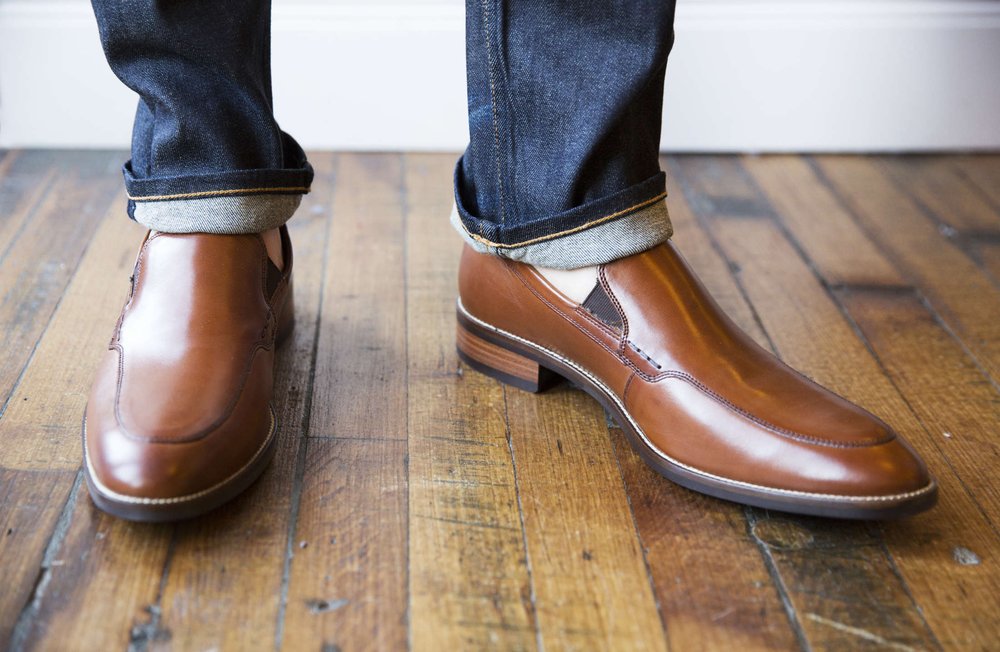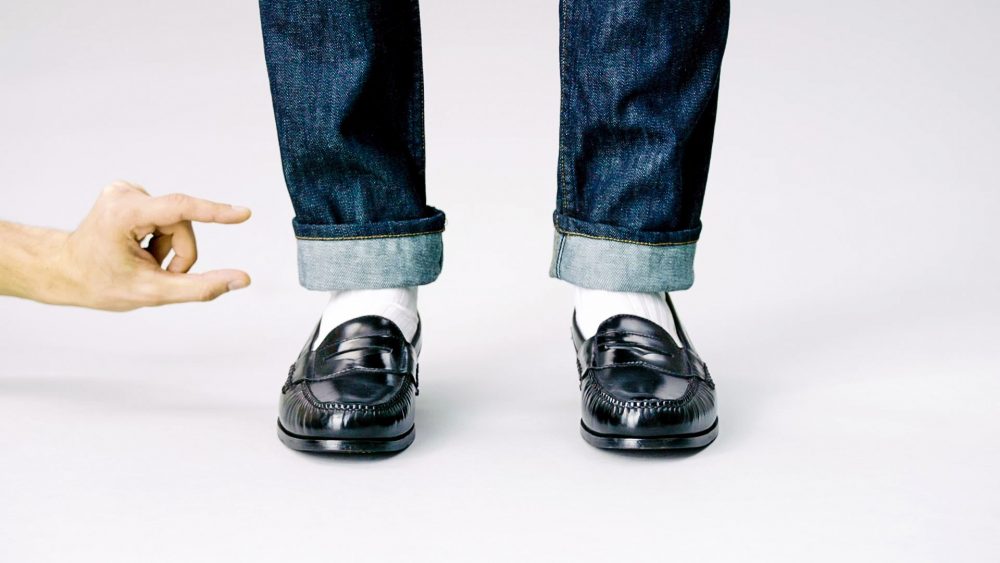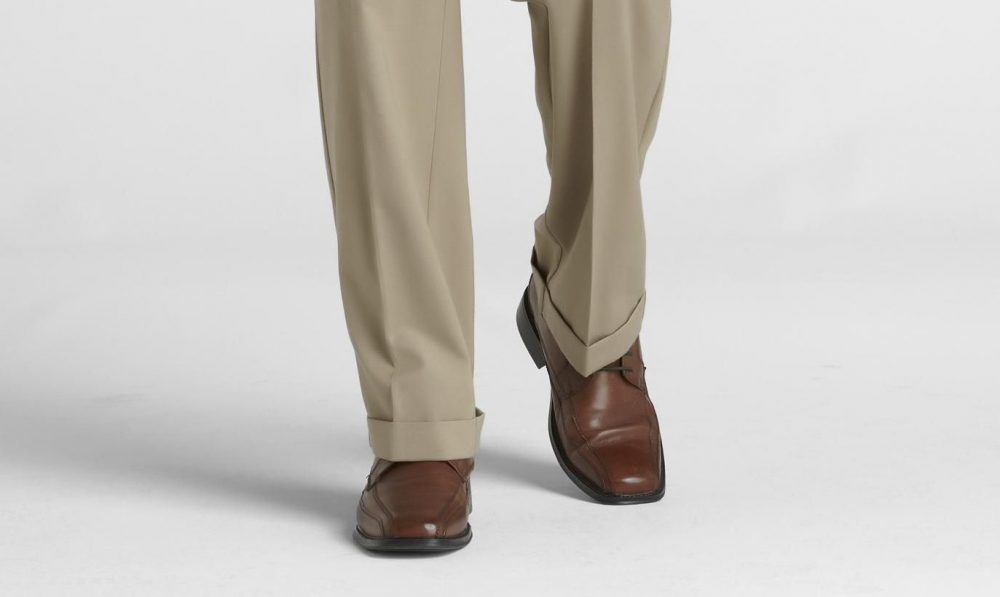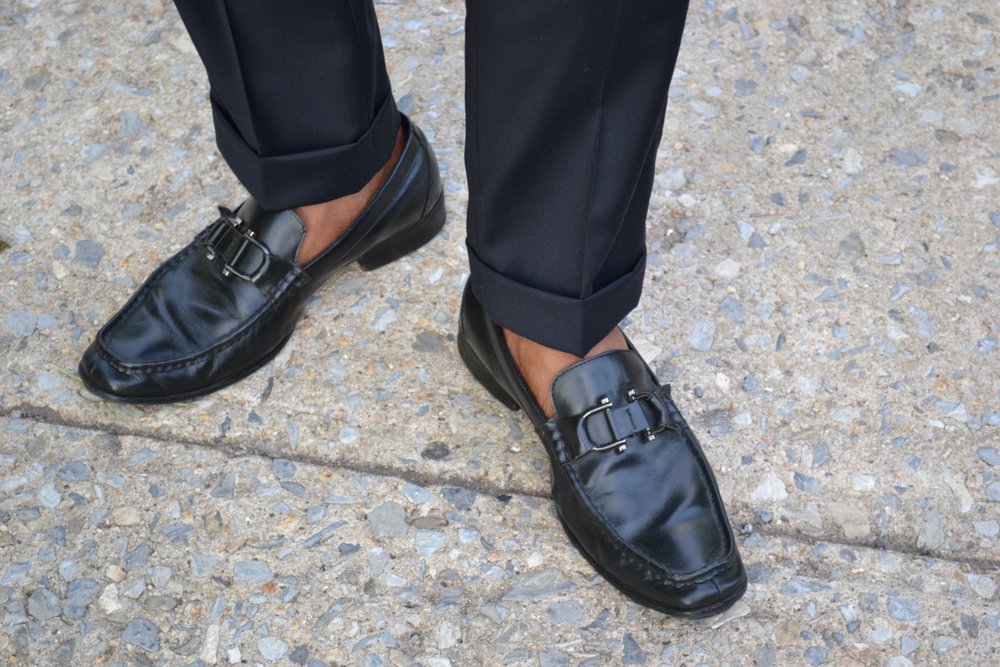Whether you’re looking to dress up or just in need of a style refresh for your daily drivers, we’ll help you sort out your priorities.
First, What Exactly Are Cuffed Pants?
All slacks have some kind of hem at the bottom, but cuffs are another beast entirely. A cuffed pant leg is one that has a notably turned-up portion at the end of the leg. They’re often then stitched in place at the seams, creating a fabric layer around the foot opening of the pants. Many may also go for a more casual look with simple hand folds, sharpen it up with a pin roll, or simple use safety pins to keep the cuff in place. Style aside, the practical purpose of cuffed pants are to help defend against damage, fraying, wetness, mud, dirt, and general wear and tear. After all, walking, biking, climbing steps, and basically any physical activity will take its toll as the bottoms of your pants rub up against the environment as well as your shoes. King Edward VII is credited for first turning up his trouser bottoms to avoid mud buildup on rainy British days. But by the early 20th century, they had become a widely adopted symbol of high-class fashion. Today, they still offer a sharp touch, though it depends on what material the pants are and how one wears them.
Why Wear Cuffed Pants?
Though the original intent of the cuff was purely functional, it has become as a mark of quality and fashion-forward dress. Bespoke tailors commonly add cuffs to their suits and trousers since they are constructing garments of higher quality than you would find shopping off the rack. When you want to add an air of style, professionalism, and class to your attire, then cuffed pants are a necessity. They alter the appearance of height and add a dressy cut to any pants. Even jeans with a cuff are more formal than those without.
Should I Cuff My Pants?
Fashion is subjective. However, if you’re looking to stick by the trends, it helps to know some ground rules about how and how not to wear cuffed pants. Keep these men’s fashion tips in mind when folding up your hems:
First, Count Your Pant Pleats
Here’s an old rule: In order to determine whether or not a pair of pants should have a cuff, counting pleats is a good way to go:
Dual pleated pants should always have cuffs.Single pleated pants can be worn with or without cuffs.Flat-front or no-pleat pants should not be worn with cuffs.
Most tailors will follow these guidelines. The reason for them is simple: Cuffs and pleats are from different wardrobe schools. Flat-front pants are continental European while cuffs represent the Anglo, English-speaking world; namely the United States and the United Kingdom. Combining the two styles often causes incompatibility and a mismatched appearance.
You Can Still Cuff Flat-Front Pants
The rule says that cuffs shouldn’t be worn with flat-front pants; traditional tailors will advise to remove the cuffs when choosing pants without pleats. But that rule doesn’t apply to full suits. Since a suit changes the overall look of a man’s frame, and you want to add as much dressiness as possible when putting on formal attire, cuffs can easily be combined with flat-front trousers so long as they are part of a suit ensemble. The one key to helping make the European pant front fit with the Anglo cuff is to ensure the rest of the suit parts are completely traditional and fit extremely well. Since you’re mixing styles on the bottom, don’t try to add flourish up top lest you look a mess.
Advice On Suits and Cuffs
Standard logic of haute couture dictates that a suit should always bear cuffed pants, because they increase the decorous nature of the outfit. The basic rule to use is that the more you wish to appear polite, precise, and proper, the more a cuff should be part of your wardrobe. A double-breasted suit should almost never be without cuffed pants, unless you are attempting to emphasize your height (or lack thereof). There are many suits that look marvelous without a cuff, and fit in perfectly well at any gathering, so long as it isn’t exclusively black tie. If you choose to wear a suit without a cuff, you want your slacks to be slightly slanted so the back side rests just above the heel. The front should have a slight break over the top of the shoe, also known as a shiver. This is to prevent your socks from showing as you move and to hide the laces of your shoes.
Don’t Wear Cuffs with Your Tux
The one addendum to wearing cuffed pants is when donning a tuxedo. Though a tux is the height of masculine attire, a cuff detracts from the smooth, fitted lines intended in the case of a black tie piece of clothing. Therefore your tuxedo should never have cuffs on the pants.
Casual Cuffs
With twill pants, chinos, or jeans, a cuff tends to be more of an optional accessory than a necessity, since you’re dressing down. If reaching for a more business casual appearance, then adding a cuff to any kind of pants can help display a underpinning of fashionability beneath the laid back look. Consider cuffing your pants with a blazer or sport coat and see the different effects it has on your appearance. Always make sure that when cuffing your pants, you have enough fabric to do it properly, and the cuff looks straight, without sloppy seams or frayed thread showing, as those ruin the look–even if it is casual.
How Long Should My Cuffs Be?
Determining how large the cuff of your pants should be is actually fairly formulaic: Standard cuff length for men of average height or below (5’9” or less) is 1.5 inches. Taller men will want a cuff that is 1.75 inches, since they are going to naturally have a longer leg.
Warning: Cuffed Pants Make You Look Shorter
The shorter a man is, or the more he wishes to accentuate his height, the less cuff he should have. A cuff shortens the appearance of a pant leg by making it appear to end sooner than it does by reducing the length of the seam line. Men seeking to make themselves appear taller would do well to avoid cuffed pants altogether, or at least reduce the cuff to a scant 1.25 inches, rather than the standard 1.5.
Complement Your Cuffs with the Right Shoes
Whatever pants you happen to have on, when you pull them into cuffs, you’re going to draw eyes downward. This means you need to have something there to see! Derby shoes, Oxfords, monk straps, cap toes, and wingtips all look smashing beneath a tasteful fold. On the other hand, penny loafers, boat shoes, and many slip-ons can appear too unrefined to make the look land properly. There’s exceptions to every rule, particularly when it comes to shoes. There’s nothing wrong with a pair of Chuck Taylors under some cuffed khakis, but that depends on where you’re going, what you’re doing, and the effect you’re trying to get across. Related Reading: Wearing Black Pants and Brown Shoes the Right Way
Cuffed Pants: Conclusion
The answer to “should I wear this?” is almost always some variant of the “it’s up to you” cop-out. And while that is certainly true, cuffed pants demand you follow some sartorial rules to look their best. Fortunately, the logic isn’t terribly hard: Pleated pants work great with cuffs, flat-front pants have some special considerations, and any type of cuffed pants make you look shorter. Keeping these factors in mind, you should be good to go adding a smart touch to your personal style. Are you big on cuffed pants? Do you agree with our ground rules for wearing cuffs stylishly? Leave us a comment below!











